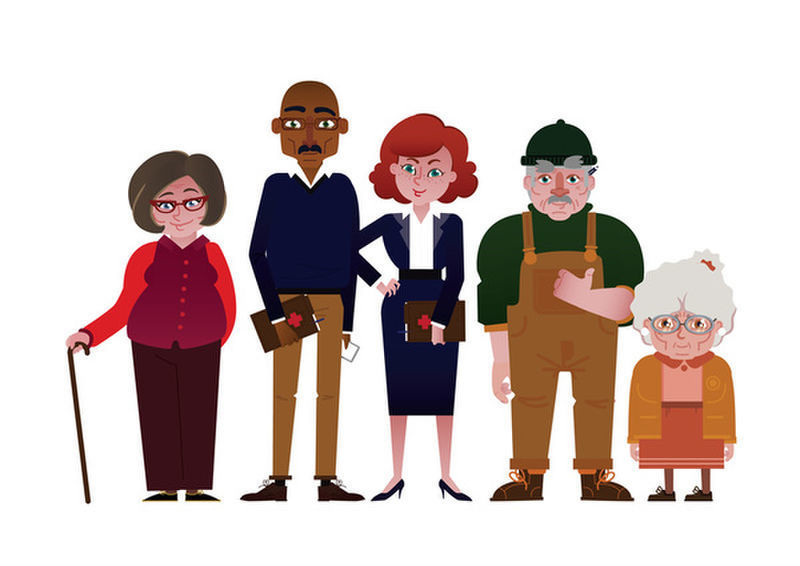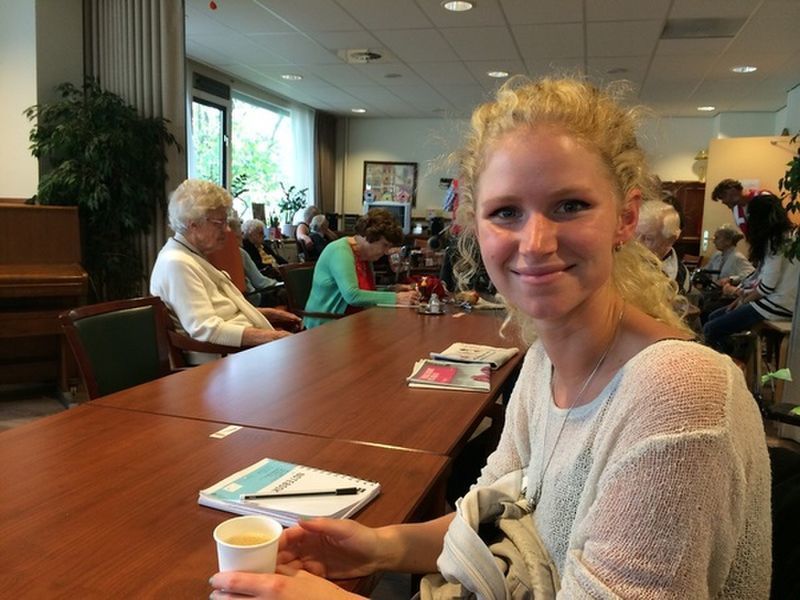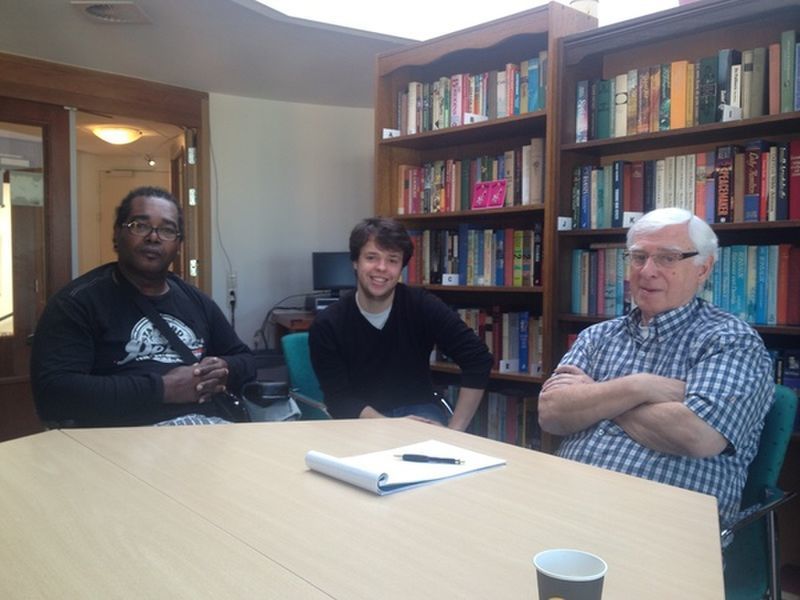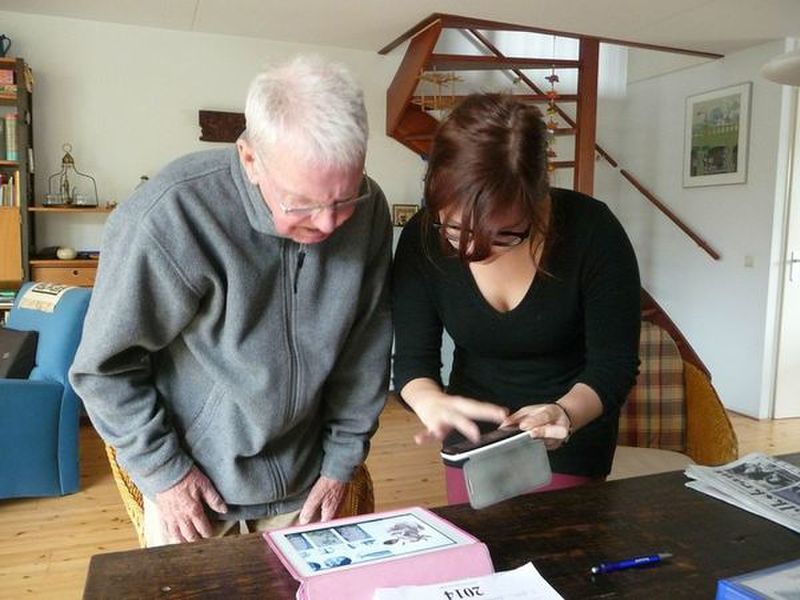The Thuiszorg Telephone
Authors: Wessel van den Berge, Bonnie van den Heuvel, Megan McNulty and Simeon Ritman,
At the moment Thuiszorg Rotterdam (Homecare Rotterdam) is facing a problem where their clients are refusing home care. This leads to situations where people are getting moved into nursing homes, even though they are physically and mentally still capable of living indepently.
A brief introduction: We are Kwartetpret Design. A small group of four people who met each other during the gamification minor of the social practices at Willem de Kooning academy. In collaboration with Rotterdam Community Solutions we took on the challenge to give Thuiszorg Rotterdam, who specialise in various types of home care, a new and positive identity. Our objective was to help the elderly find a way to live independently in their own homes for as long as possible, by making homecare available to them. That’s why we researched Thuiszorg Rotterdam as an organisation, next to that we also took a thorough look at the needs of the elderly who were already receiving care at home. Before we could develop a plan for the elderly get home care, we needed to know why, up untill now, they they often refuse help.
During a visit to the Laurens Antonius Nursing Home, which is located on the Nieuwe Binnenweg in Rotterdam, we met Wilhelmina Valk, one of the elderly. She told us she was recovering from her recent hip surgery, so her stay would only be temporary. She could not wait to go home and thanks to the hip surgery she would finally be able to do her own groceries shopping again. Something she enjoys and takes pride in doing at her age. But she did have a problem, normally the heavy front door of her apartment is a hassle for her to open and close it. But it would be an even bigger hassle with her now fragile hip. So she asked Thuiszorg Rotterdam if they could help her with her problem and the solution they offered her was: “Don’t worry Ms. Valk, we will do your groceries for you”. However this was not the solution Wilhelmina was hoping for. Without her groceries shopping she would skip on her daily physical and social needs and would lose her independence. Even though Thuiszorg Rotterdam would like the help they simply don't have to manpower to fix her problem in any other way.
Sadly Wilhelmina is not the only elderly with a story like this. A lot of other elderly we spoke were bothered by the fact that they had lost the feeling of being in control of their own situations, lives and decisions. The fact is that the older we get things change. We all become less capable physically. This could start out as physical challenges but could also lead to a negative impact on our mental state. Realising these changes may not only be frightening, but also be hard to accept. The fear of change and decline only gets bigger when you start needing help from an organisation like Thuiszorg Rotterdam. This leads to a paradox: elderly people want to get help staying independent, but when Thuiszorg Rotterdam tries to help by taking over and offering general solutions, they only take their independence away. So we wanted to find a way to support the independence of the elderly by letting them find solutions themselves.
So we asked ourselves a simple question: What is the first thing we do when we ‘younger’ people have a problem? Where do we find information in this day and age? Wilhelmina might have thought of a button to automatically open her front door. But where can she get one? She does not own a computer and doesn't know how to use one. So using the internet isn’t an option. And let’s be honest, the first thing we would do, is to google it. This got us thinking, what if we could offer Wilhelmina and other elderly in the same situation the functionalities of the internet, what if we could turn Wilhelmina into a google expert, so she would find all the answers to her questions? And why stop there? What if we could also show her how to chat online, and meet all kinds of people! To offer her those functionalities of the internet we had to find a medium which all of the elderly could understand and use.
We thought of various media we could use, like print or the telephone. These are examples of communication that have been around for quite a while. Everyone understands how to use them. The problem with print (posting) is the time needed to receive an answer to a question, which leads to a lack in direct contact and interaction. We wanted to make sure its possible to ask a question and receive an answer right away. The telephone perfectly provides those requirements. So how do we use the telephone to help elderly use the internet? We initially thought of an automated telephone service. After finishing tests with a simulation of a pre-programmed answering service it became clear the target audience needs more than a robot to answer their questions. Without human interaction the unique needs of Wilhelmina would not be fulfilled. So we came up with a more personal and friendly solution: De thuiszorgtelefoon!
The Thuiszorg Telephone Clients of Thuiszorg like Wilhelmina receive a package from there carer. In this package they will find all sort of goodies and gadgets, a leporello (harmonica book) and a welcome letter with a short introduction to the Thuiszorgtelefoon and inviting them to start using the phone service and join in on the fun. In the leporello each category gets explained, for each category we designed a different host. With storytelling, small games and the phone service we created a pervasive game experience. In a pervasive game the boundaries of the game are unclear. This makes reality and play mix which leads to an even better experience where ‘players’ aware or unaware are being supported and motivated by the world we created.
The first phone line is run by Toon and Toos, the health care coaches. You could see this as an online profile. The useful thing of a profile is having an overview of yourself and your situation. Toon and toos tell you everything you need to know: about what you are entitled to, when you should take your pils, which carer will be taking care of you, and when they are coming over. But also where and how you could get a button to automatically open your heavy front door. Calling Toon and Toos should help you find answers for all of these questions. The line is answered by an employee of Thuiszorg Rotterdam taking on the roll of Toon or Toos. By training the employees to answer the phone with: “Hello this is Toon” (if male, if female they use the name Toos) it unknowingly takes the client into the world of the Thuiszorg telefoon. Thus the pervasive game. Because the clients have already been introduced to Toon and Toos through the welcome letter, and leporello it creates a sense of safety and recognition.
The second line provides the functionality of online chatting and is hosted by Babbette. We wanted to make it possible to go online or offline, as you would do when chatting on the internet. That’s why there a two options, You can create a message, indicate from when till when you are available and await the calls. Or you can listen to available messages (profiles) of people awaiting a phone call, the online players simply select yes or no after they have been asked if they want speak to the person (player) of which they have just heard a message. If they answer yes, the other person gets a call, if no, they go on to the next message till they find a chat partner. The system needs minimal guidance after the first use. Also in the leporello we provided an easy game how to break the ice and start a conversation.
The third and final telephone line came to life as a solution for finding the answer to everyday questions and problems. Providing a search engine system like google would be vital in order to allow the user to gain access to lots of knowledge and information. The character hosting this service is Nico, but he won’t be doing this alone. In order for these needs to be met we needed real people on the opposite side of the phone, volunteers. We found “Het Nieuwe Vrijwilligen” a new kind of volunteering. Instead of expecting a volunteer to be available for eight hours straight, a volunteer can now say “I am available for half an hour, and later in the day I will have another 45 minutes in which I am also available.” By designing an app for them and adding the option to turn themselves “on” or “off” we cater to this need. The advantage of this kind of volunteering is that people can start helping whenever they themselves want. They don’t have to clear their whole schedules but they can help in their breaks or when they are waiting for the bus. In this way we connect people who want to volunteer but have limited time to elderly people who can use their knowledge of the internet. By connecting the caller to a volunteer through Nico we make the volunteers part of the game and world.
The app, which serves as a platform, grows by user generated input. Within the platform, we provide motivation though different game mechanics so we can engage two types of players within the app and thus the game. The first type will be motivated by extrinsic rewards in the app, showing their progress with strong visual rewards, like badges and achievements. This group has a good knowledge of how to use the web and can share this with the elderly calling the service. The second type is triggered by the idea of helping people, So we give them tools to create a log about all the elderly they helped, serving a more intrinsic value. This gives them an epic meaning of being helpful towards others, and also enabling them to read back the stories they wrote. These players also provide the data for the database, filled with the answers to questions that have already been asked. Thus making it easier for other users of the app to answer questions in the future by consulting the user generated database. Combining these two target audiences and making them both part of the same pervasive game, enables us to solve the problem of the elderly, and to give volunteers the feeling of being part of something bigger, in an easy way. This group of volunteers can grow easily because of its flexible and approachable platform.
The Thuiszorg Telephone is a practical and social tool for people who receive care at home which introduces them to the functionalities of the internet in a playful way. The hosting characters create a new and positive identity for Thuiszorg Rotterdam, resulting in a better attitude towards the organisation and giving the elderly the feeling of being in control of their situation.
Megan McNulty - Illustration student WdKA with a minor in gamification. Simeon Ritman - Illustration student WdKA with a minor in gamification. Wessel van den Berge - Graphic design student WdKA with a minor in gamification. Bonnie van den Heuvel - Copywriter, student at WdKA with a minor in gamification.




